The best Italian steak recipe in Italy—aside from the Florentine Steak, of course— has to be the Tagliata! Tagliata is a sirloin steak cooked to perfection (usually, rare) and plated as thin slices (tagliata means cut in Italian). It’s a traditional Tuscan dish, and is thought to be a reinterpretation of another Tuscan classic: Bistecca alla Fiorentina.
Traditionally, Tuscan Tagliata is prepared on a grill. However, you can easily make Tagliata at home in a pan or skillet—and we’ll show you how to do that step-by-step in this pan-seared steak recipe!
Watch the Video Recipe!
Video recipe for the best Italian Steak Recipe: Tagliata, as featured on the PIATTO™ YouTube Cooking Channel. Turn on the subtitles to watch it in English. Coming soon (narrated in English).
Subscribe to our YouTube Channel
More video recipes? Subscribe to our YouTube Channel (it’s FREE) and click the bell to get notifications when we release a new video recipe!
Best Italian Steak Recipe: Tagliata Ingredients
Like so many authentic Italian recipes, you don’t need many ingredients to make this dish, but the ingredients you do use should be high quality! For the Tagliata, that means we need quality steak, the right fat for searing the steak in a pan, and some salt.
Choosing the Steak
To make ItalianTagliata, choose a quality sirloin steak. The one we’ve chosen here is a…
- Chianina sirloin (chianina is an Italian breed of cow famously raised in Tuscany)
- Weight: about 1 lb (.5 kg)
- Thickness: about 1 inch (2.5 cm) thick
- Aged: 3-4 weeks
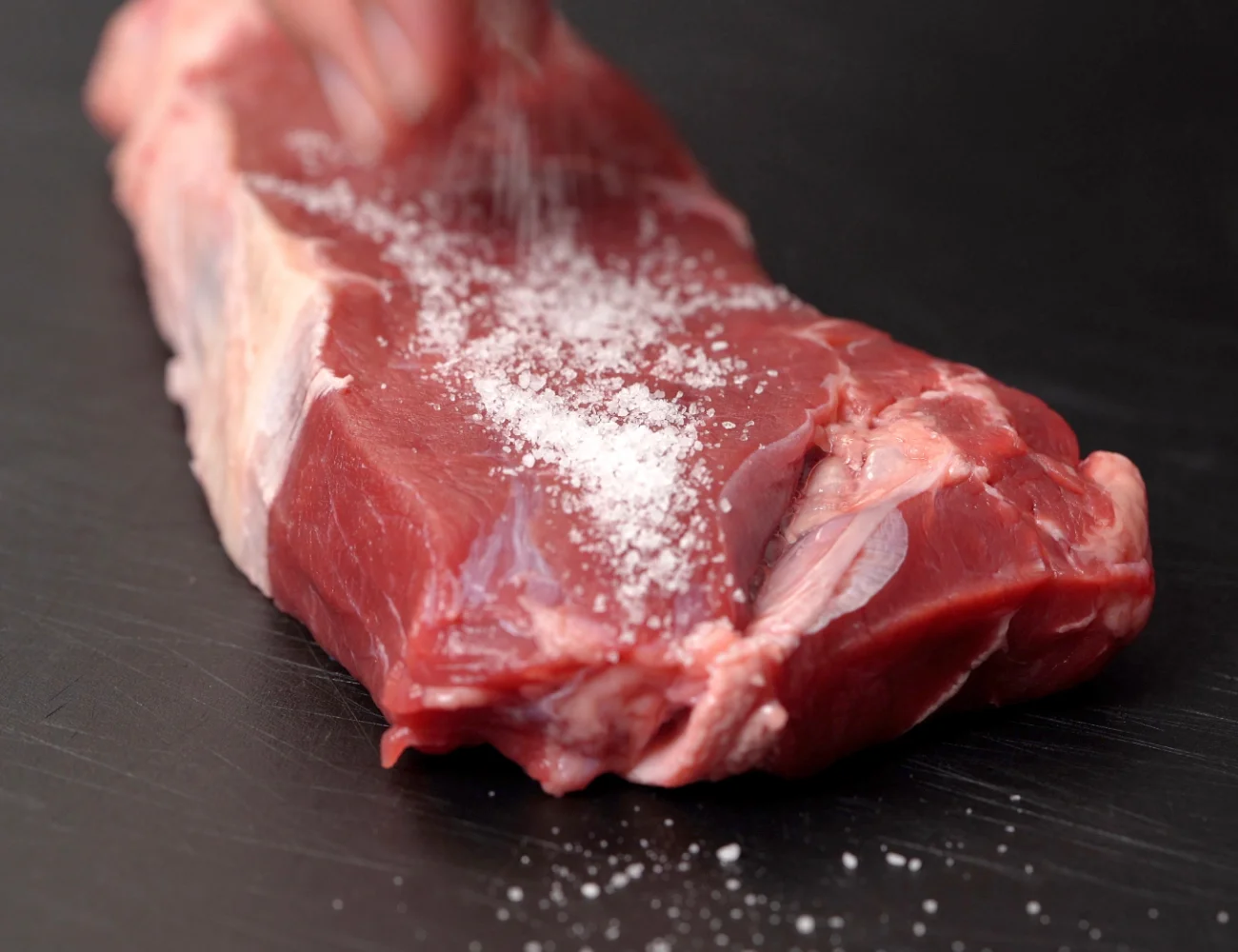
Fat? Clarified Butter
Clarified butter is the fat of choice for searing steak in a pan. It has a smoke point of 482° F (250° C)— much higher than unclarified butter. Don’t have clarified butter on hand? No worries! Learn how to make clarified butter easily at home using normal unclarified butter in our guide.
Clarified butter will not burn so it will not produce pyrolysis of carbohydrates or proteins because it has none.
Salt and Olive Oil
Salt is fundamental to preparing the steak properly, as we will discuss. In this sense it’s both a main ingredient, and a possible condiment.
All other condiments are optional, though you may want to finish the steak with a drizzle of extra virgin olive oil as they do in Tuscany. We often finish ours with a sprinkle of flake salt as well.
Condiments
A great way to serve Tagliata? With a simple arugula salad and a demi-glace with aged balsamic vinegar—which you could also drizzle over the salad. Arugula (rucola in Italian)
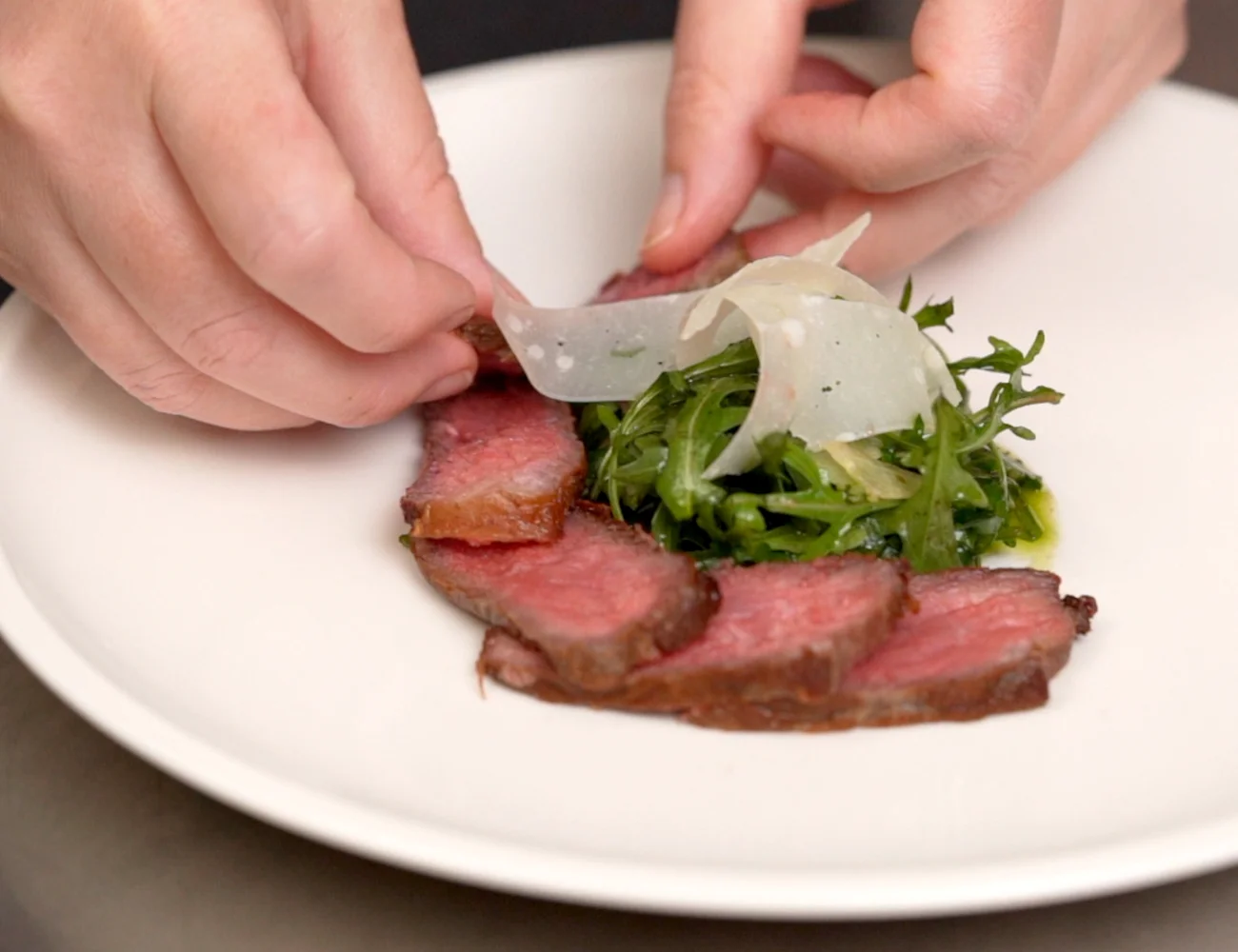
How to Cook Pan-Seared Steak for a Tagliata
Traditionally, a Tuscan Tagliata is cooked on a grill. We’ll cover how to do that in another guide. Pan-searing steak in a pan is both easy and will produce a delicious result—as long as you use the right tools for the job!
Assuming you’ve already selected a quality steak, the first step is to salt it correctly!
Salt the Steak.. Then Wait 2 Hours
Salt the steak generously on both sides, pressing the salt into the meat. Then, let the steak rest for a couple of hours.
Salting is a critical step! To explain why (with a bit of science): When we add salt to our meat, we alter the osmolarity within the fibers of the meat. Naturally the juices will be attracted towards the surface (where the salt is). However, as the salt distributes inside the sirloin, the juices will also redistribute and an osmotic balance will be once again reached.
That means if we wait a couple of hours after salting, very little juice from the steak will be lost.
Do not listen to the alleged experts especially on the net who advise you to salt only at the end of cooking…
These are people who carry on out of routine, mechanically, out of preconceptions… and I’m also talking about chefs, not just enthusiasts…
Don’t listen to so-called experts who advise to only salt at the end of cooking the meat. It’s fine to add a sprinkle of fine, coarse of flake salt at the end, but that salt will never penetrate the meat. The result will be meat that is overly salty on the surface and lacking flavor inside.
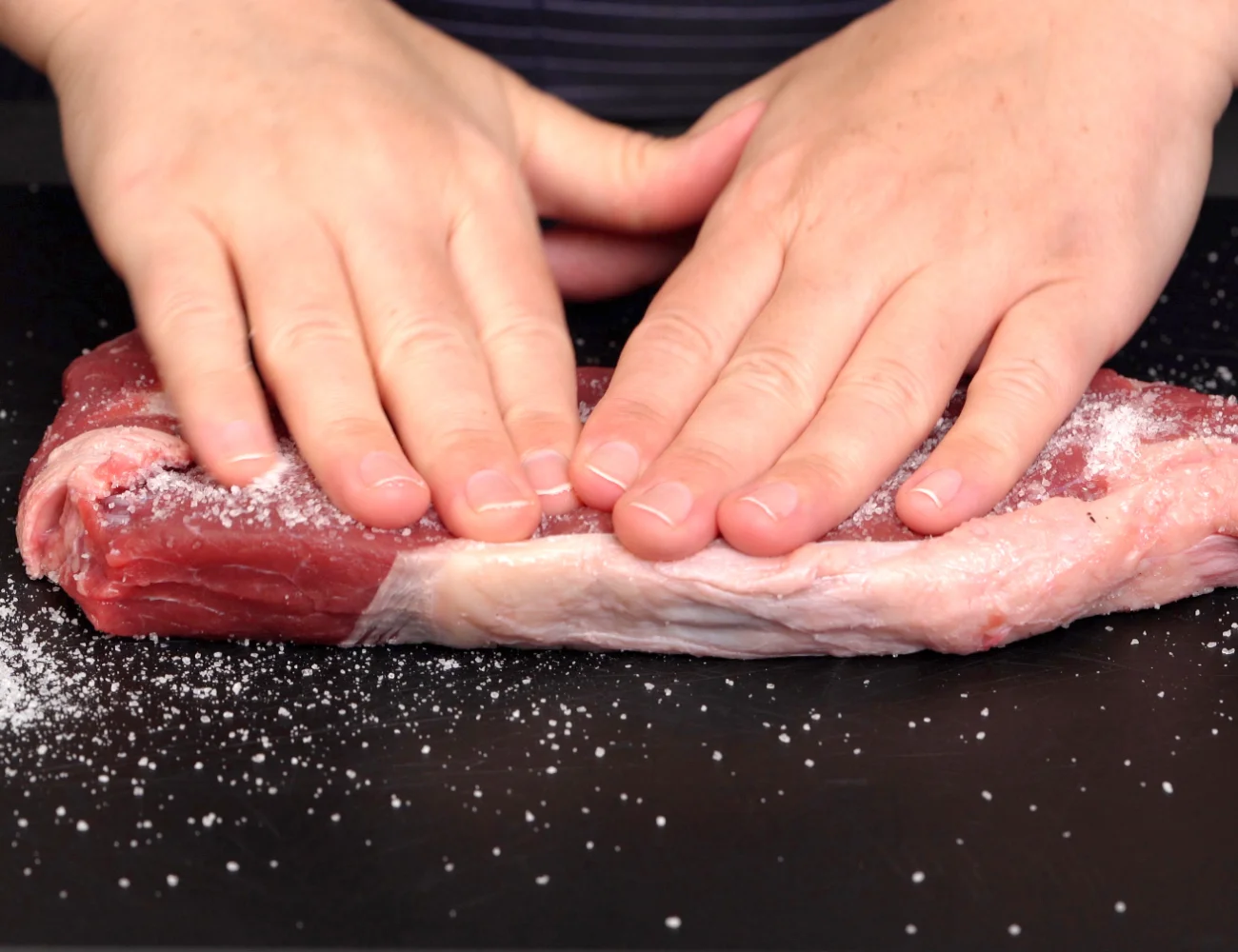
Wrap the steak in plastic wrap and put it in the fridge for 2 hours.
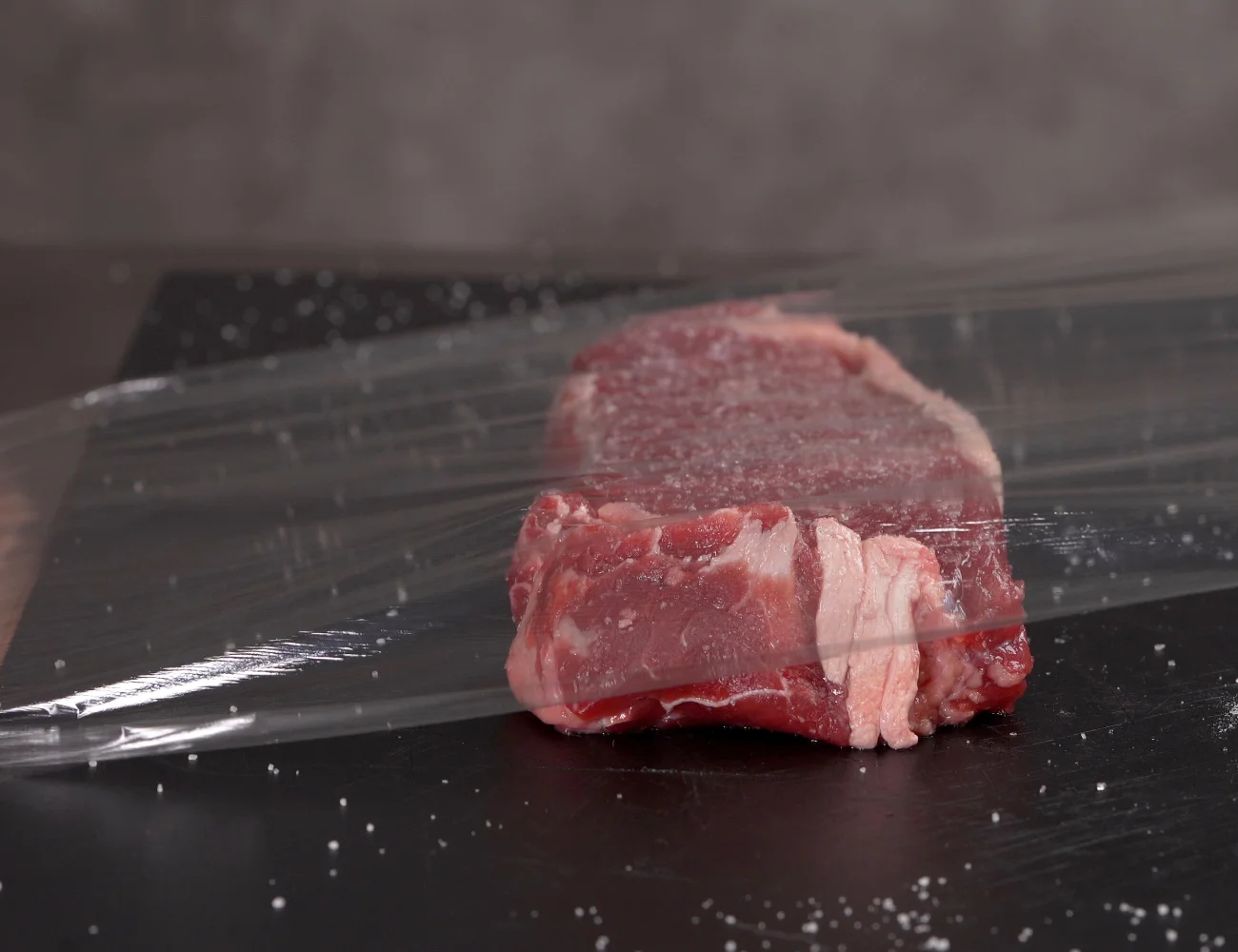
After the 2 hours rest, let the steak come to room temperature for about 1/2 hour before cooking it. During the rest time, you can prepare any sauces or condiments you may want for your finished steak.
After the 2 hours, the steak will have lost very little juice. At this time, we remove any excess fat or extraneous parts of the steak which we then use for stew.
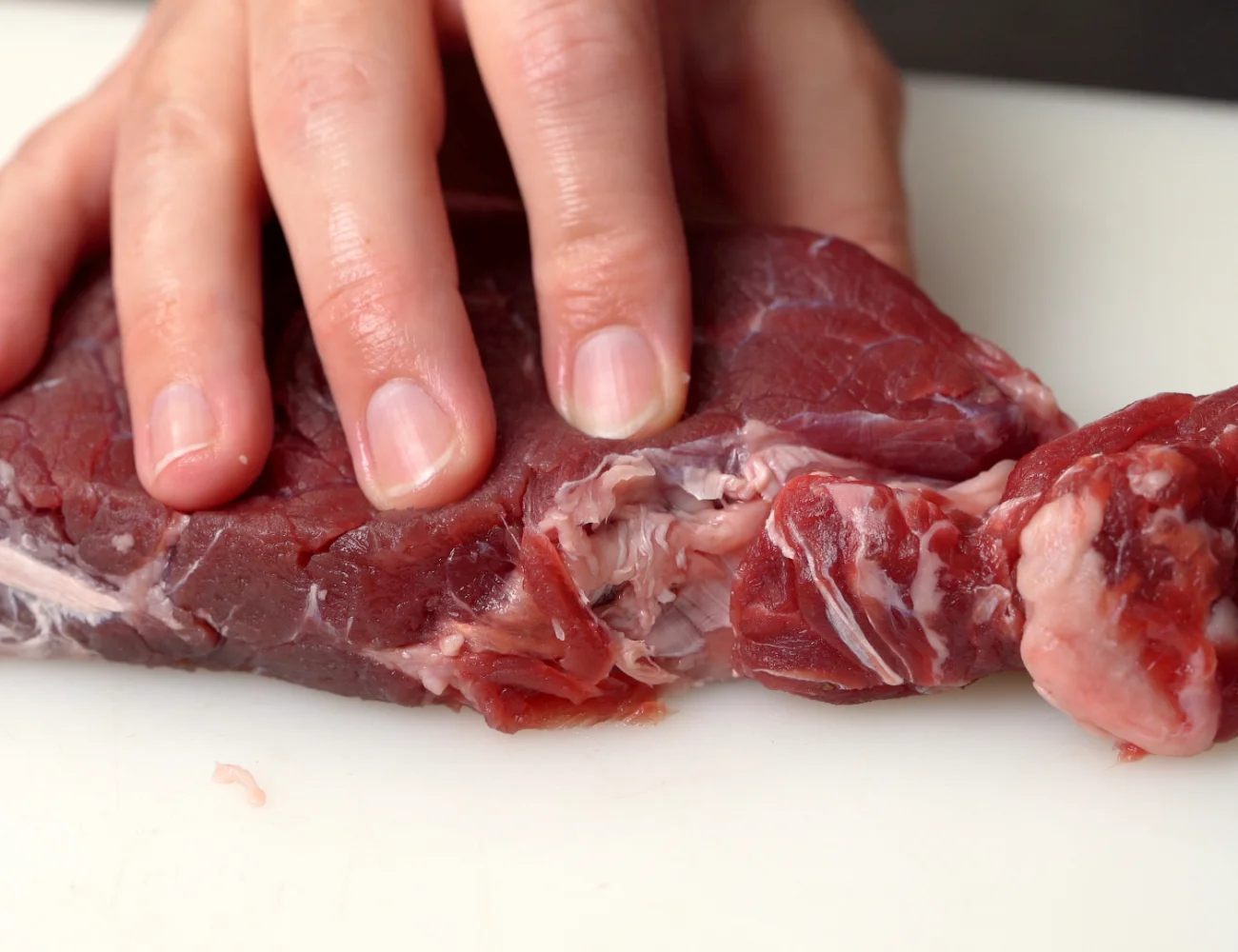
Pan Searing the Steak
The Right Pan for the Job
Just as important as choosing the right fat for pan-searing the steak (clarified butter) is selecting the right pan for the job.
Use a seasoned cast iron or carbon steel pan. These pans take a bit longer to heat up, but retain heat very well for an even cook. All this translates into a homogeneous and above all fast cooking time. Also? We are using high heat to pan sear our steak —around 662° F (350° C) —so this high heat will irreversibly warp a pan that is not suited for the job.
Here’s the pan we use, as seen in the photos and video (affiliate link):
- Carbon Steel Pan, 11″: https://amzn.to/3Mt9bru
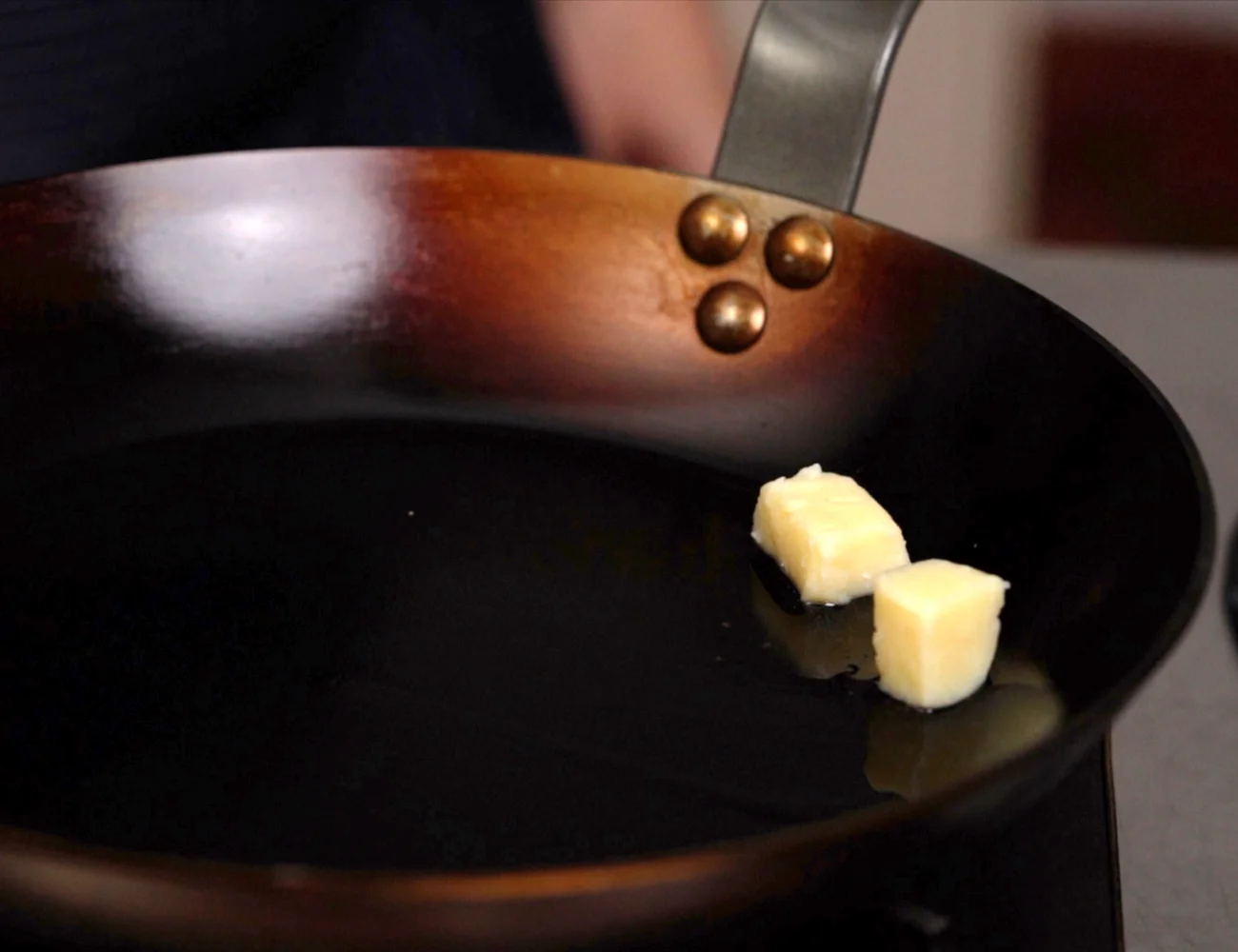
Sear on High Heat
When the pan reaches a temperature of around 662° F (350° C), it’s time to cook the steak! The goal is to produce the Maillard reaction as quickly as possible in order to minimize the loss of juices. This reaction is already triggered above 120° C, so we have a stronger reaction at the 350° C that we are using to cook the steak.
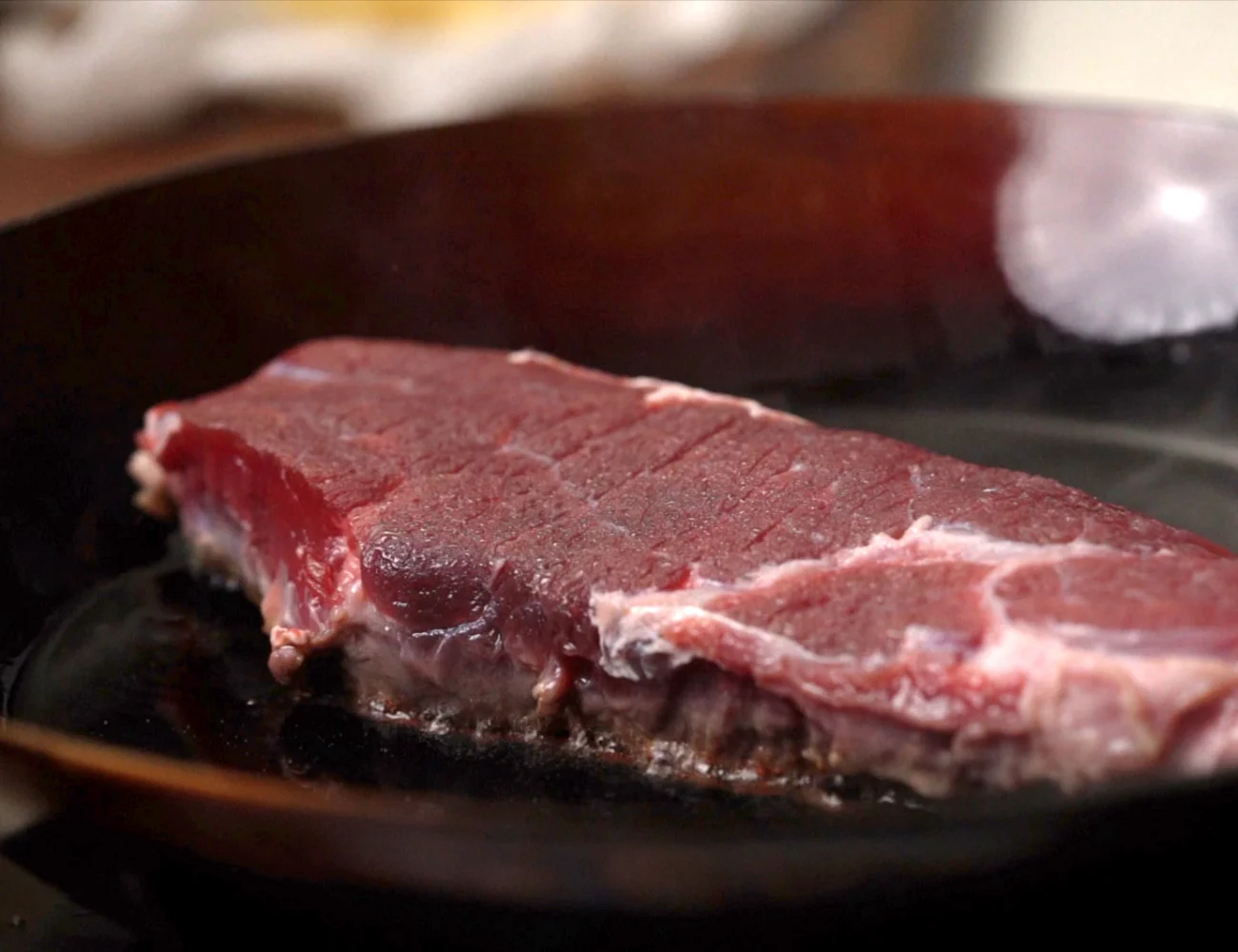
We only need to sear the steak for a couple of minutes per side (as you’ll see in the video). Sear until the surface steak of the steak looks like the ours (seen below). Then, flip it and sear the other side of the steak.
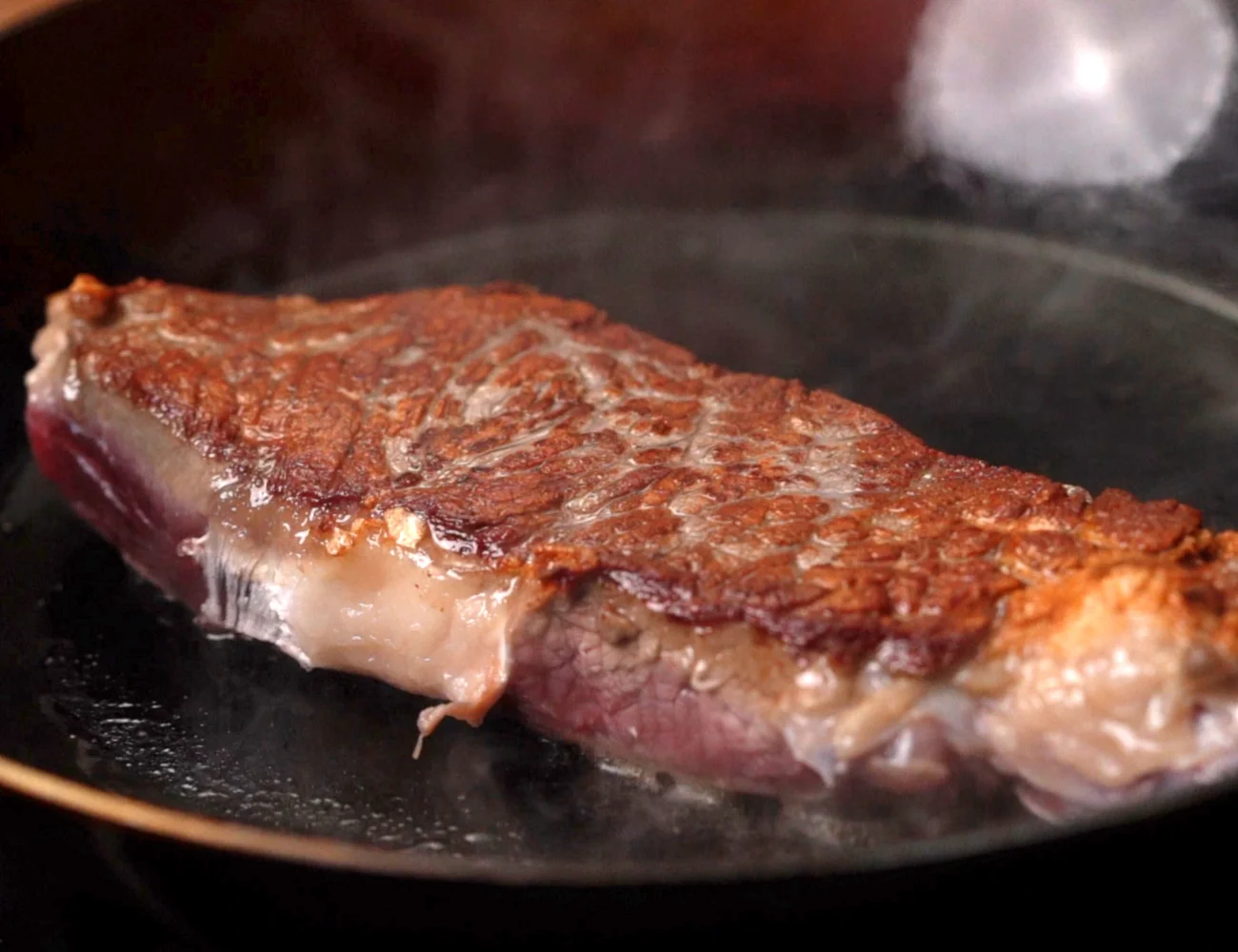
You’ll want to baste the surface with the hot butter, as we are doing here…
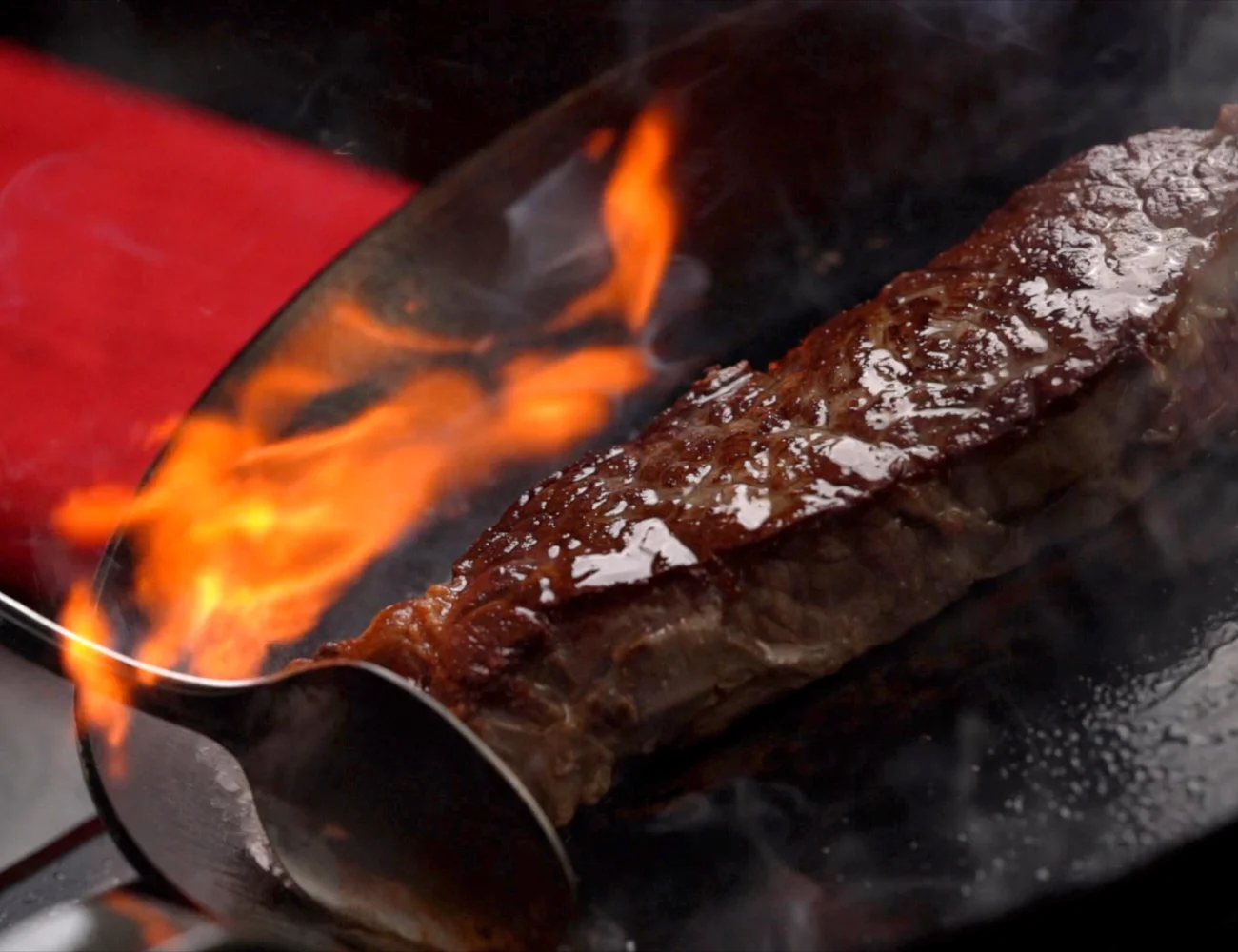
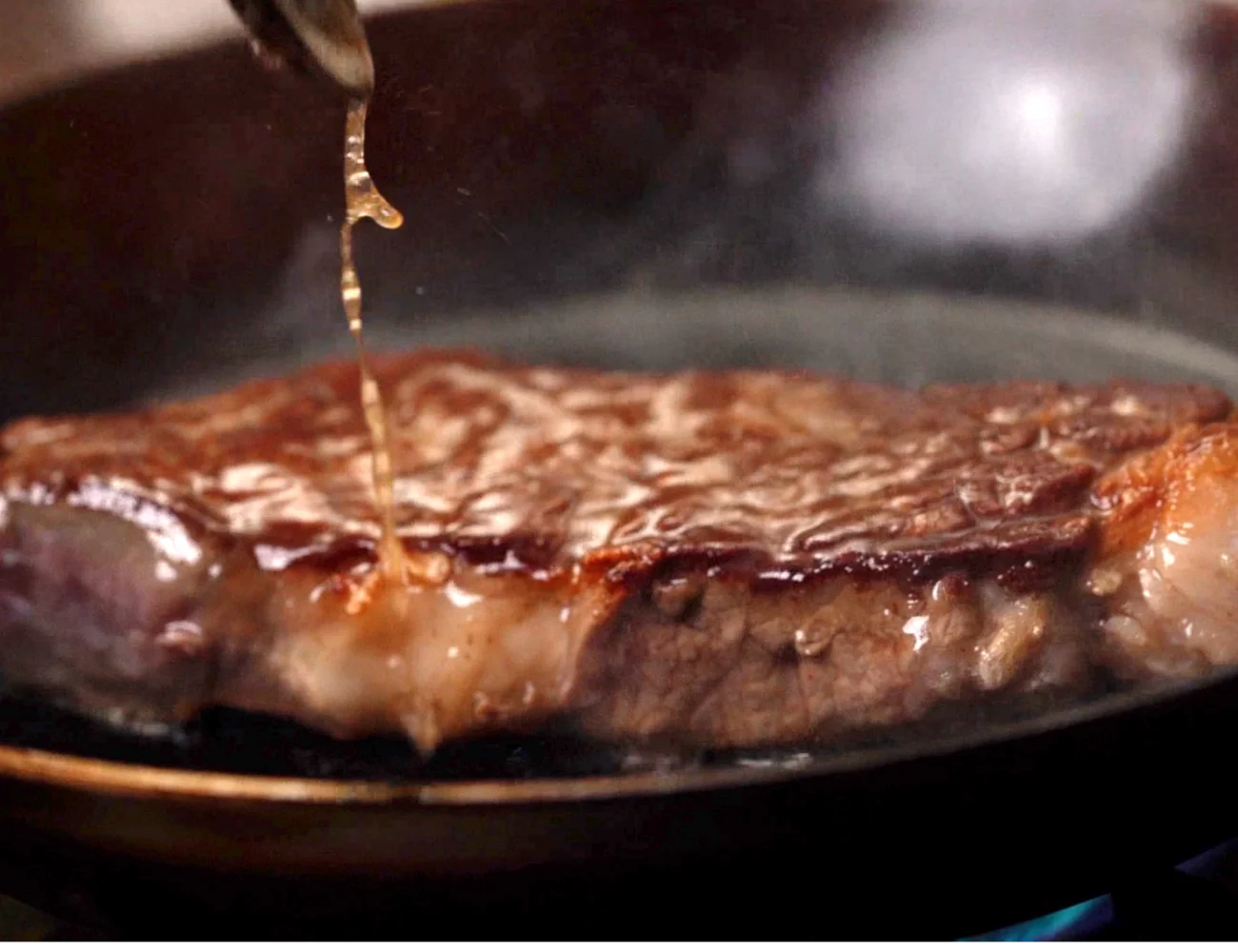
And finally, be sure to sear the sides of the steak as well!
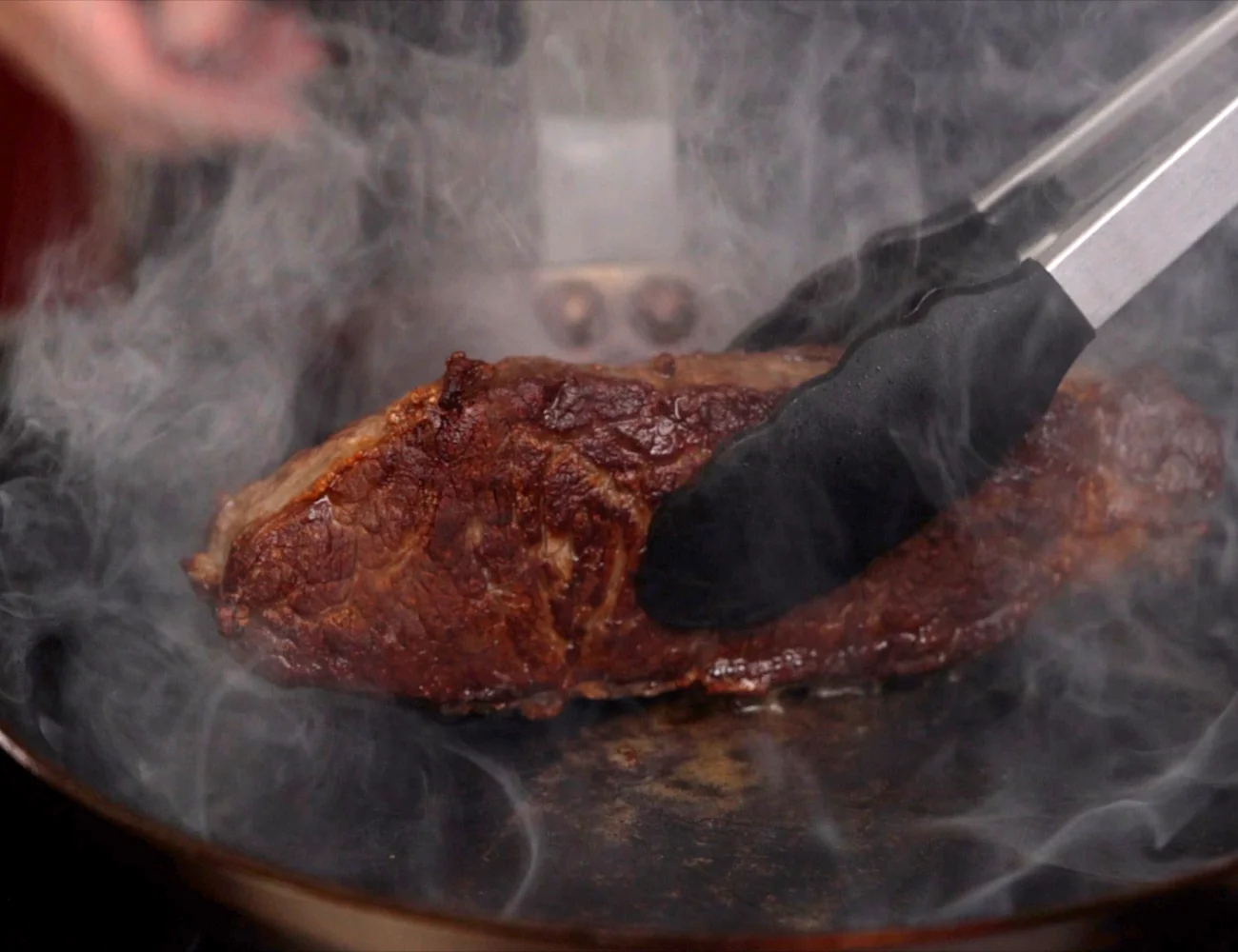
Let the Steak Rest Before Cutting It!
Once the steak is properly seared and ready, it’s time to let it rest! This is not optional!!
Let your steak rest 10 minutes before cutting it, under penalty of losing the juices inside!
Let the steak rest for ten minutes before cutting it, under penalty of losing the juices! This is because the juices are in the center of the meat right after you remove the steak from the heat. It takes a few minutes for the juices to redistribute throughout the steak. So we leave the steak rest for at least 5 minutes—10 minutes if we manage to resist the temptation. Only then do we cut our steak open to make the Italian Tagliata!
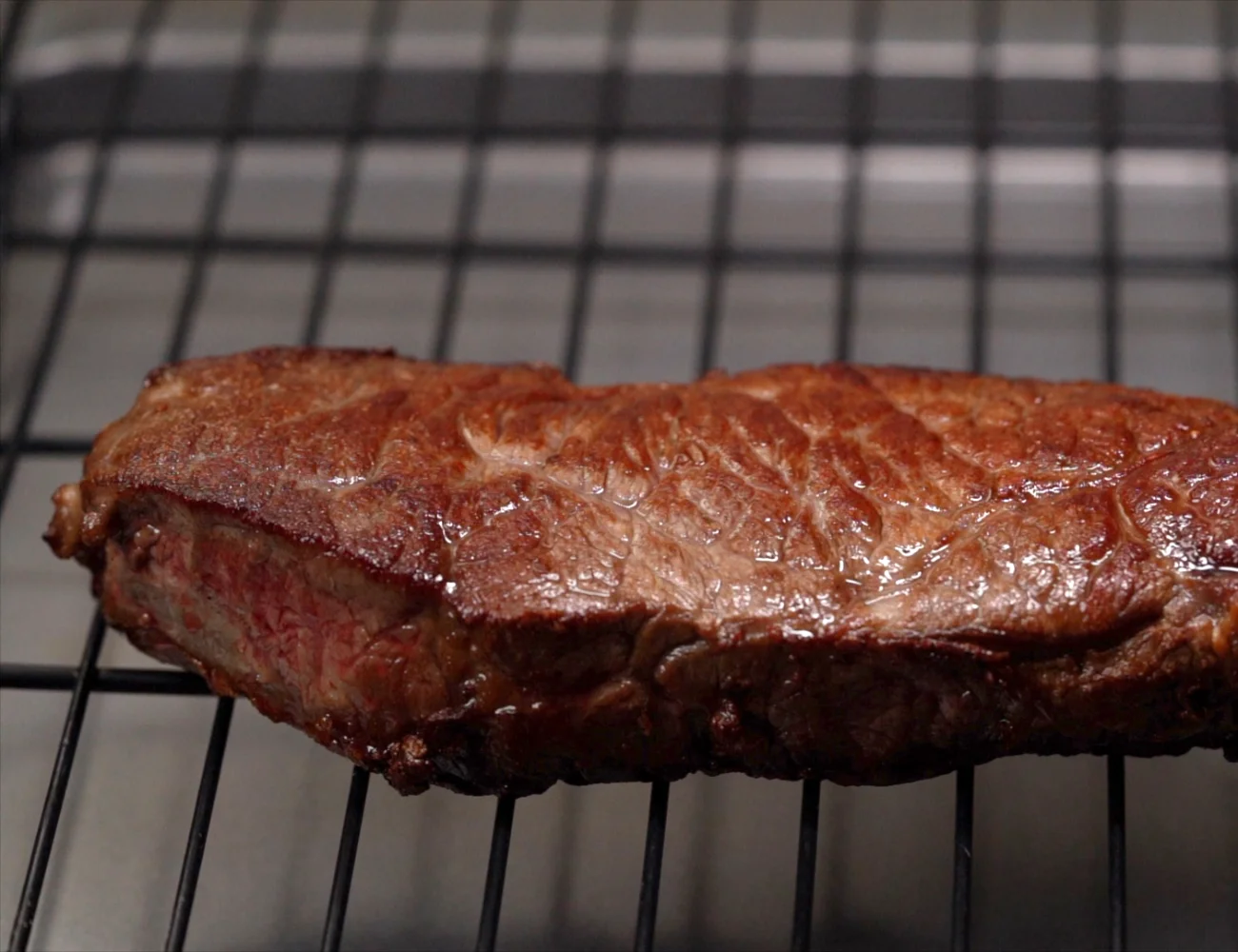
In the meantime, you’ll want to warm the plates you plan to serve the meat on (to about 113° F or 45° C).
De-Glaze, Demi-Glace?
Once the steak is cooked, we like to de-glaze the pan with a demi-glace, add a few drops of our favorite balsamic vinegar, let it reduce… and filter!
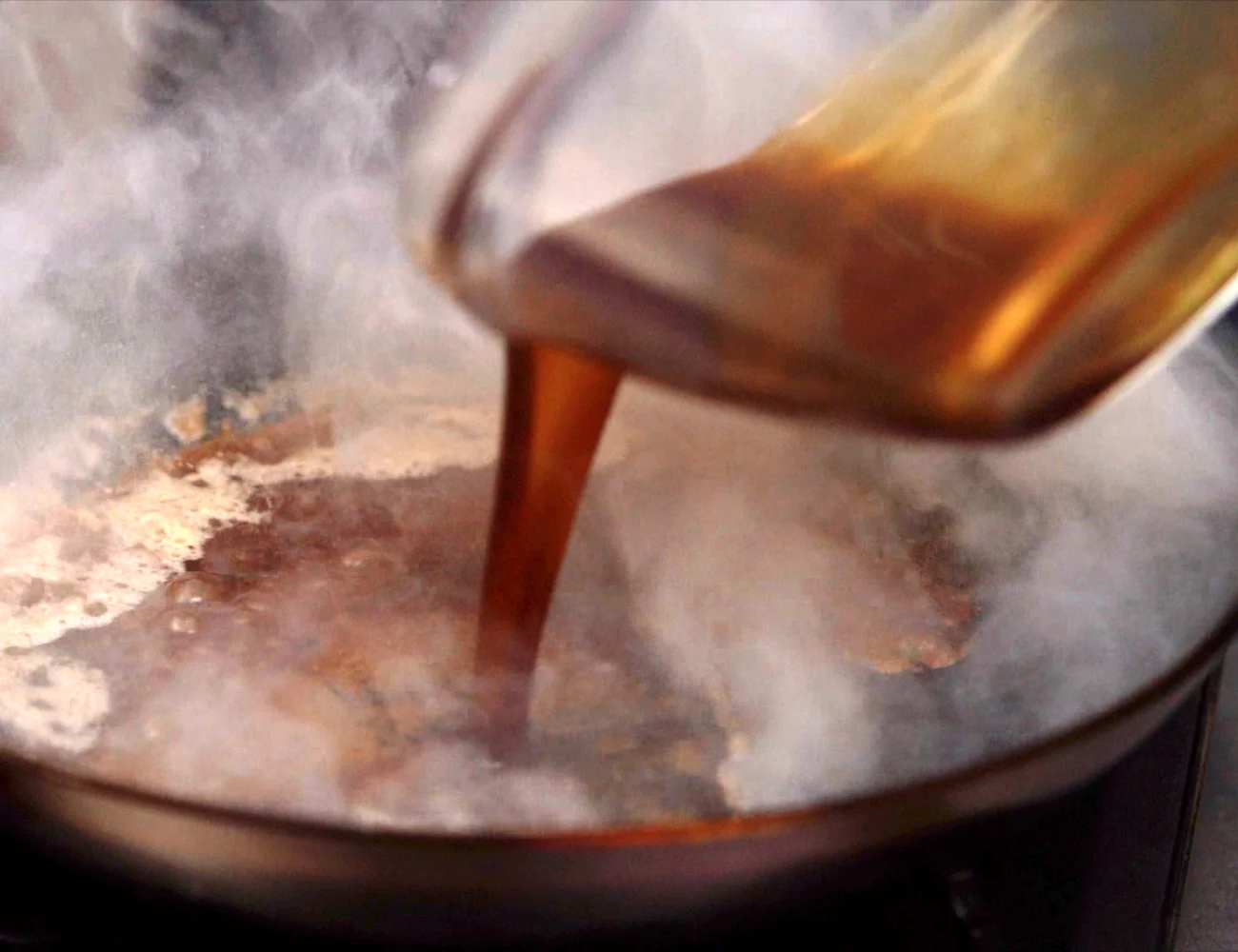
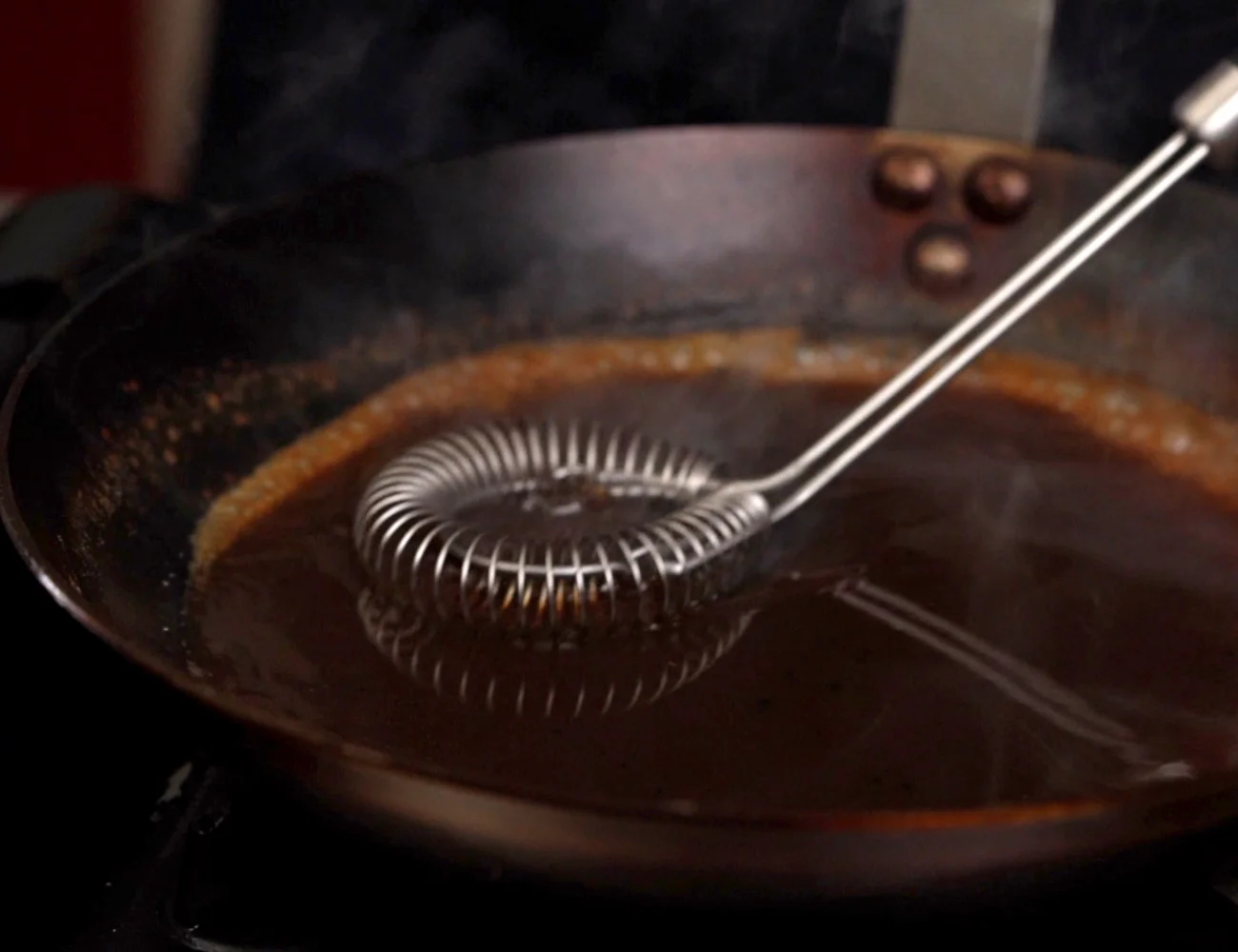
Plate and Serve the Slices of Italian Steak (Tagliata)
Thinly slice the steak to your liking. The slices you see below are probably the most common for the Italian Tagliata, however you can even cut thinner slices!
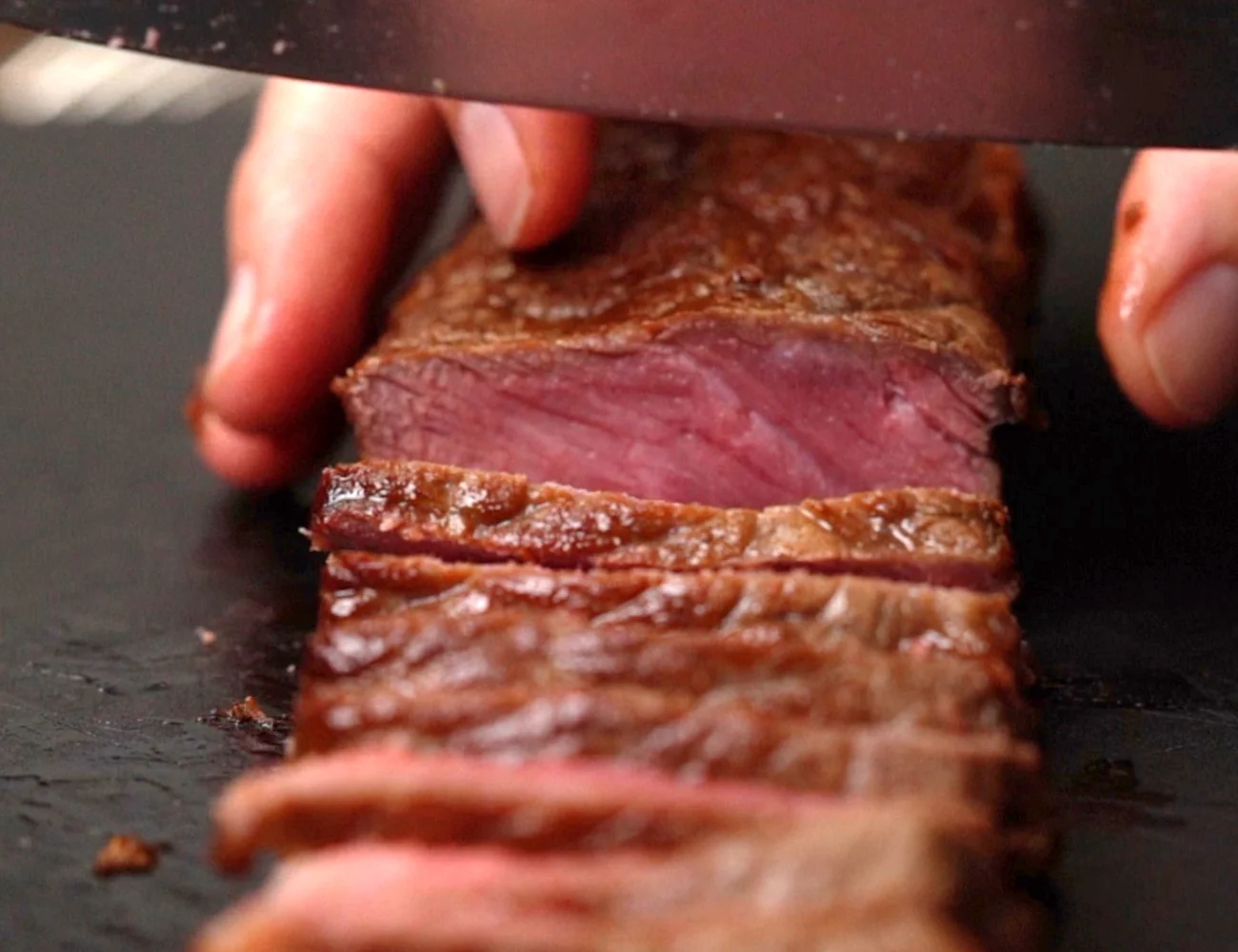
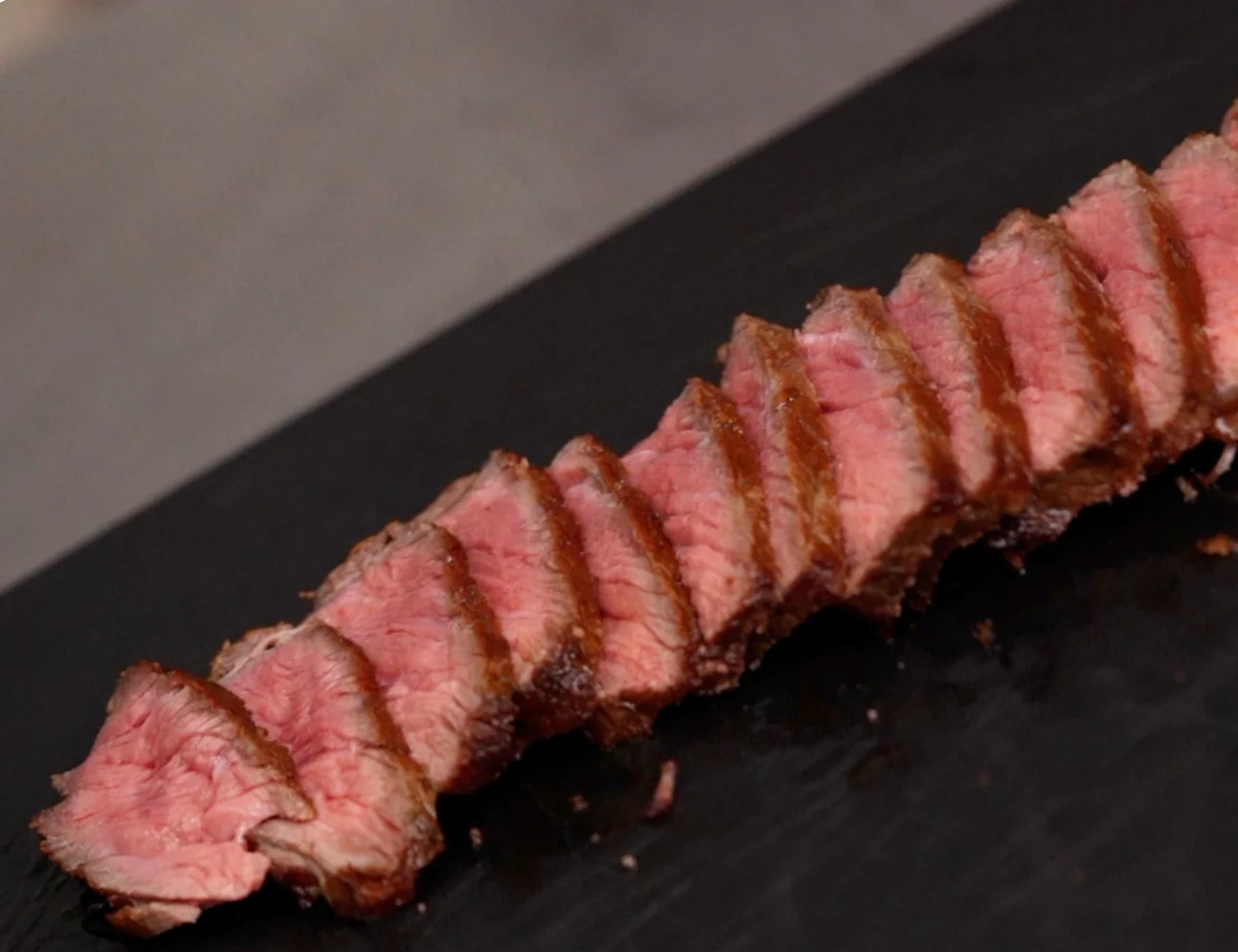
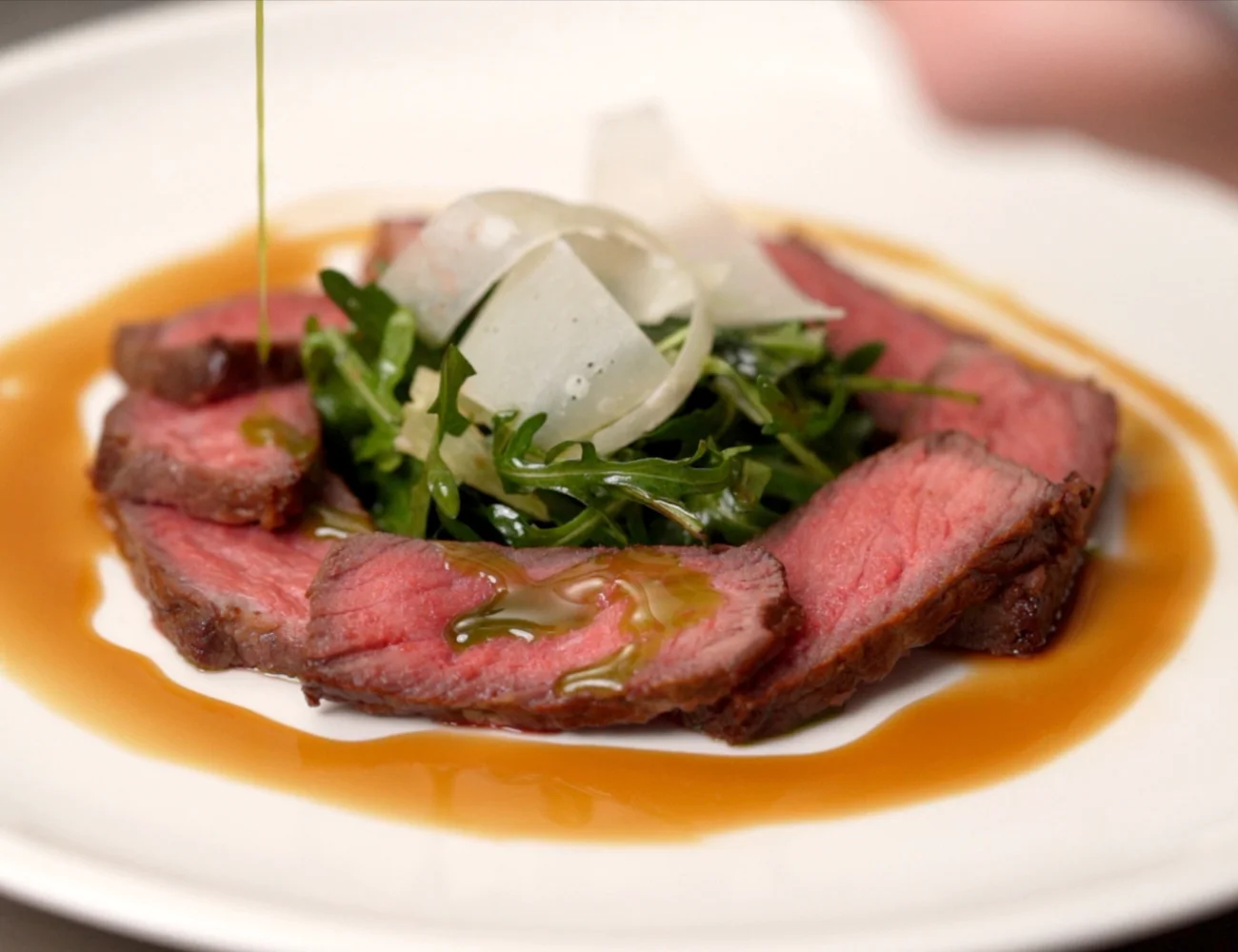
Discover More Italian Food Recipes!
- Creamy Spaghetti Carbonara Recipe with Cooked Egg Sauce
- Spaghetti Cacio e Pepe
- Authentic Ragu Bolognese Sauce Recipe
As an Amazon Associate, we earn from qualifying purchases. This means at no extra cost to you, PIATTO may earn a small commission if you click the links and make a qualifying purchase.
Best Italian Steak Recipe: Tagliata (In a Pan)!
Equipment
- 1 seasoned cast iron or carbon steel pan about 14" in diameter
- plastic wrap
Ingredients
- 1 lb aged sirloin steak "controfiletto"
- fine salt to salt the steak
- 2 tbsp clarified butter to sear the steak
Optional Condiments
- demi-glace
- balsamic vinegar aged
- arugula
- grana padano or Parmigiano cheese thinly sliced
Instructions
Prepare the Steak
- Salt the steak generously on both sides, pressing the salt into the meat.fine salt, 1 lb aged sirloin steak
- Wrap the salted steak in plastic wrap. Then, let the steak rest for about 2 hours in the fridge.
- After the 2 hours rest, let the steak come to room temperature for about 1/2 hour before cooking it. At this time, you'll also want to remove any excess fat or extraneous parts of the steak—which can be used to make broth or a stew. During the rest time, you can prepare any sauces or condiments you may want for your finished steak.
Pan Sear the Steak
- Over high heat, bring a seasoned cast iron or carbon steel pan to a temperature of around 662° F (350° C). Melt a few tablespoons of clarified butter in the pan.2 tbsp clarified butter
- Cook the steak for a couple of minutes per side—until the surface of the steak is golden brown but not burnt (see photos).
- Then, flip the steak and sear the other side.
- You’ll want to baste the surface of the steak with the hot butter during the cooking, as shown.
- Sear all sides of the steak as well.
Rest the Steak (Covered)
- Once the steak is properly seared and ready, it’s time to let it rest! This is not optional! Let your steak rest 5-10 minutes before cutting it, under penalty of losing the juices inside! It's best to cover it loosely with foil while it rests.Read the whole article on this page for a thorough explanation as to why the rest is needed.In the meantime, you’ll want to warm the plates you plan to serve the meat on to about 113° F (45° C).
De-Glaze and Make a Sauce (Optional)
- Once the steak is cooked, you can also de-glaze the pan with a demi-glace…demi-glace
- Add a few drops of quality (aged) balsamic vinegar, let the sauce reduce… and filter!balsamic vinegar
Slice the Steak and Serve it!
- Thinly slice the steak to your liking.
- The slices you see in the photo are probably the most common for the Italian Tagliata, however you can even cut thinner slices!
- Top with a sprinkle of coarse, flake or fine salt (optional). You can also finish the Tagliata with a drizzle of fresh extra virgin olive oil, the balsamic demi-glace or even an infused olive oil as we've done here!A simple arugula salad (with a drizzle of olive oil and a pinch of salt) makes an excellent side. We like to top ours with a thin slice of Parmigiano Reggiano cheese.arugula, grana padano or Parmigiano cheese
- Buon Appetito!
Video
🇬🇧 This is the English-language version of our original Italian recipe on PIATTO Ricette.
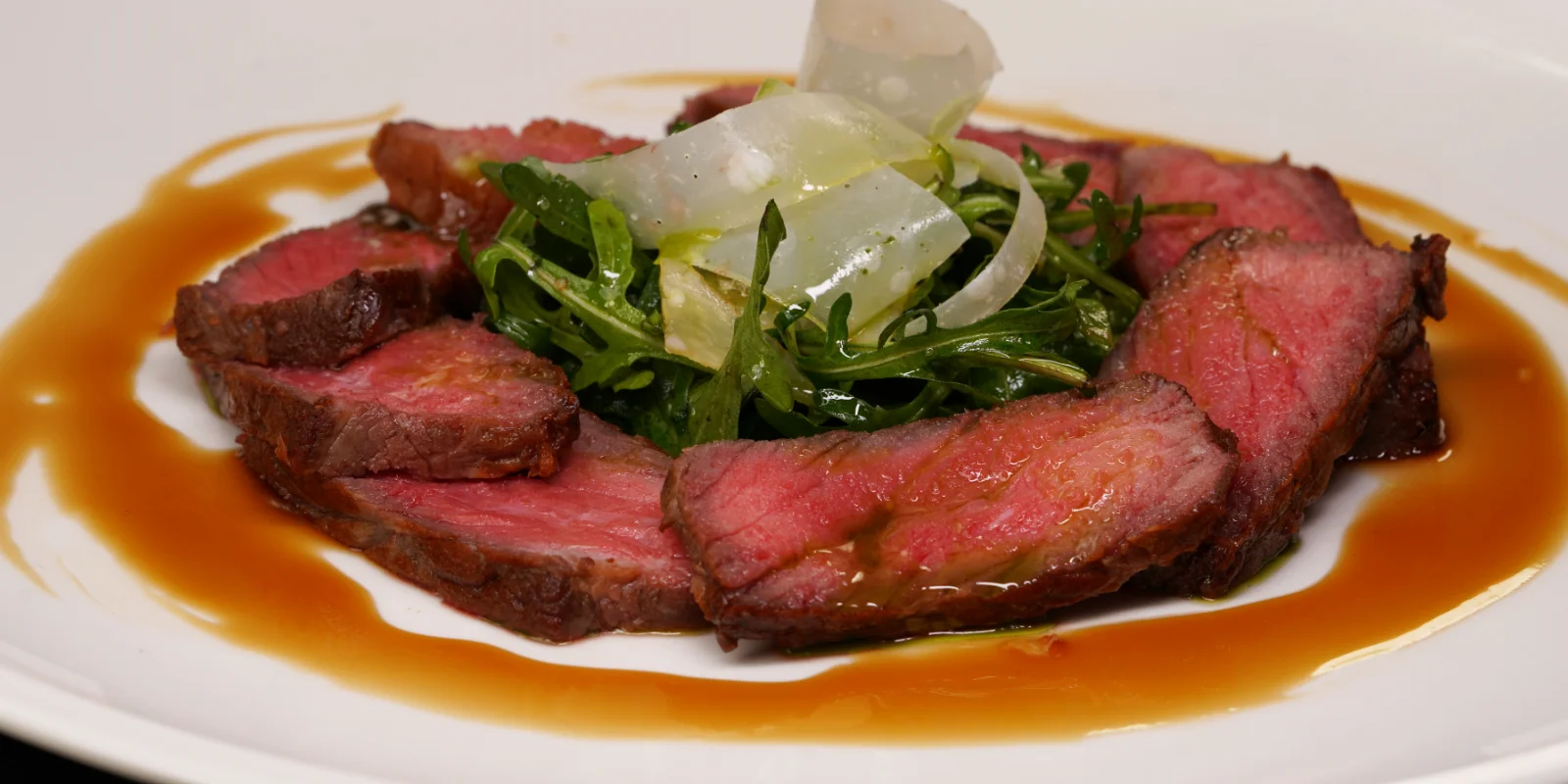
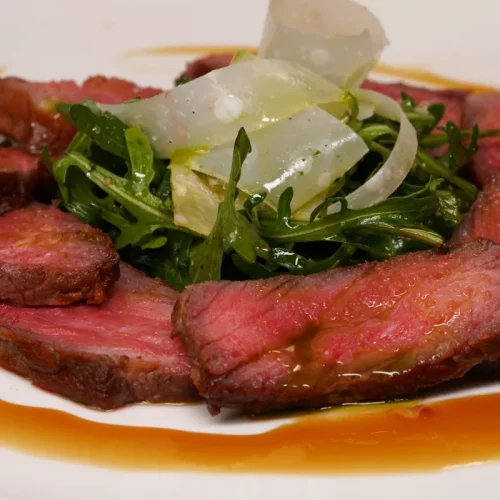
“Et oui!!! La cuisine italienne c’est pas seulement les pâtes 😉 qu’elle super recette plein de conseils. 👍 Je sais ce que je vais me cuisiner demain 😃 cela ne fera que la 12eme recettes que je fait de « Piatto » et jamais déçu. 😃 et tellement d’autres a faire! 👍. ( merci pour les sous titres Fr 😜 )”
“Non conoscevo tutti questi segreti e quindi il gusto non era buono ora eseguiro’ alla lettera quello che fai vedere e…. anche senza camino mangerò una ottima tagliata grazieeee”
Il tempo di riposo della carne: la lascio sul tagliere oppure la metto in un cartoccio di alluminio perché magari si fredda troppo?
Original comment: View on YouTube
Alto livello
Original comment: View on YouTube
Si può fare con una padella antiaderente? Ho provato ma non so se dipende da questo, la carne si “gonfia” e non diventa rossa con la crosticina uniforme, in alcuni punti rimane marrone, in alcuni punti sembra farla invece. Poi oddio il gusto non è male, ma sono certo non sia come quella del video.
Original comment: View on YouTube
Perfection! I followed your instructions and it came out wonderfully. Thank you Chef.
Original comment: View on YouTube
si puo fare con la bavetta?
Original comment: View on YouTube
Ottima. L’ho riprodotta stasera a casa con un pezzo di entrecôte da 300 g circa.Non me ne vogliate, ma a me la tagliata piace proprio “ben cotta”, quindi una volta sigillati entrambi i lati l’ho incisa a intervalli regolari da una parte per controllarne il colore, aggiunto il coperchio (in vetro) e continuata la cottura per un minuto circa. Infine l’ho finita di tagliare sempre in padella e ho concluso la cottura con un altro minuto e un’altra noce di burro.Non mi era mai venuta così buona!!! Grazie!!!
Original comment: View on YouTube
Scusi la fismma medio alta per tutta la durata?
Original comment: View on YouTube
Eccellente
Original comment: View on YouTube
È una meraviglia! GrazieColgo l’occasione per chiedere un metodo casalingo per frollare la carne. Questo perché non trovo quasi mai la carne già frollata. Ringrazio
Original comment: View on YouTube
Buongiorno, la padella che temperatura deve raggiungere prima di posarvi la tagliata. Grazie.
Original comment: View on YouTube
E questo è l antipasto… poi? 😂😂😂😂😂😂😂
Original comment: View on YouTube
Perfetto. 👏👏👏forse 30 secondi troppo cotta. X il resto assolutamente perfetto. Anche il filtrare la salsa. Che molti non fanno. Ma è importantissimo. Complimenti x l’attenzione ai dettagli. Che poi dettagli non sono. Come rifilare la carne dal grasso in eccesso. Sempre. E il burro chiarificato. Che ormai dovrebbe essere obbligatorio. Chapó 👏👏👏
Original comment: View on YouTube
Una descrizione veramente chiara e piena di dettagli Bella da vedere e sicuramente ottima da gustare Proverò a prepararla seguendo tutti i vostri consigli.Grazie piatto
Original comment: View on YouTube
Come si frolla per 4 settimane ?
Original comment: View on YouTube
Interessante. Una domanda: come si fa a far arrivare la tagliata ben calda all’ospite considerando tempi di riposo, tempi di scaloppatura e impiattamento (su piatto caldo) ?
Original comment: View on YouTube
Show
Original comment: View on YouTube
Et oui!!! La cuisine italienne c’est pas seulement les pâtes 😉 qu’elle super recette plein de conseils. 👍 Je sais ce que je vais me cuisiner demain 😃 cela ne fera que la 12eme recettes que je fait de « Piatto » et jamais déçu. 😃 et tellement d’autres a faire! 👍. ( merci pour les sous titres Fr 😜 )
Original comment: View on YouTube
Non conoscevo tutti questi segreti e quindi il gusto non era buono ora eseguiro’ alla lettera quello che fai vedere e…. anche senza camino mangerò una ottima tagliata grazieeee
Original comment: View on YouTube
Straordinaria finalmente anche senza camino si può fare una buonissima tagliata evviva 👏👏👏👏
Original comment: View on YouTube